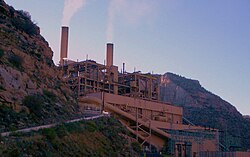Coal
Coal is a hard rock which can be burned as a fossil fuel. It is mostly carbon but also contains hydrogen, sulphur, oxygen and nitrogen. It is a sedimentary rock formed from peat, by the pressure of rocks laid down later on top.
Peat, and therefore coal, is formed from the remains of plants which lived millions of years ago in tropical wetlands (coal swamps), such as those of the late Carboniferous period (the Pennsylvanian). Charcoal is made by wood heated in an airless space.
Coal can be burned for energy or heat. About two-thirds of the coal mined today is burned in power stations to make electricity. Like oil, when coal is burned its carbon joins with oxygen in the air and makes a lot of carbon dioxide, which causes climate change. Many people die early because of illnesses from air pollution from coal. Most countries are turning to other sources of energy, such as solar power and wind power. But new coal power plants are still being built in some parts of the world, such as China.
Coal can be roasted (heated very hot in a place where there is no oxygen) to produce coke. Coke can be used in smelting to reduce metals from their ores.
History
Coal was the most important fuel of the Industrial Revolution.[1] Coal was an important part of rail freight in the UK in the 20th century, forming the greater part of several companies' freight volume. Early in the 21st century most coal fired power stations in the United Kingdom and several other countries were closed to reduce greenhouse gas emissions.
Types of coal

Under suitable conditions, plant material is transformed step by step into
- Peat is not yet coal.
- Lignite (brown coal) is the dirtiest coal, is about 60%-70% carbon, and is used as fuel for electric power generation. Jet is a compact form of lignite that is sometimes polished and has long been used as an ornamental stone.
- Sub-bituminous coal is used as fuel for steam-electric power generation. Also, it is a source of light aromatic hydrocarbons for the chemical synthesis industry.
- Bituminous coal is a dense rock, black but sometimes dark brown. It is a relatively soft coal that breaks and burns readily and quickly. It used as fuel in power stations, and for heat and power applications in manufacturing, for blacksmithing; and to make coke to make steel.
- Anthracite is a harder, glossy, black coal. It is longer burning, and used mainly for residential and commercial space heating.
- Graphite is difficult to burn and is not so commonly used as fuel. It is still used in pencils, mixed with clay.[2] When powdered, it can be used as a lubricant.
Diamond is commonly believed to be the result of this process,[source?] but this is not true. Diamond is carbon but is not formed from coal.
Coal contains impurities. The particular impurities determine the use. Coking coal has little ash or sulfur or phosphorus. Those would spoil the iron made by the blast furnace.
Environmental problems
Coal, when burnt, gives off almost a third more carbon dioxide per unit of energy than oil, and 80% more than natural gas. Almost half of the carbon dioxide from people is because of burning coal so it is the biggest single cause of global warming.[3] Coal contributes to acid rain and smog, especially when burned without scrubbers. Burning coal releases toxic chemicals, including soot, mercury, and carbon monoxide, which contribute to diseases such as cancer and asthma in both humans and wild animals. Coal mining, especially mountaintop removal mining, can damage large areas of land and destroy natural habitats. Higher grades of coal burn more cleanly than lower grades, although they still pollute more than other fuels. In addition to air pollution, burning coal produces toxic coal ash, which can cause water pollution if it is accidentally released into the environment. There are several underground mine fires burning throughout the world. These underground fires release toxic smoke into the air, and can also cause the ground above to collapse. The city of Centralia, Pennsylvania was evacuated and is now abandoned due to an underground coal mine fire.
Deaths and illness from pollution
Because of coal every year more than one hundred thousand people die early[4][5][6] and millions of people get ill.[7] Coal miners often get pneumoconiosis (black lung disease) from exposure to coal dust.
Protests against coal

Opposition to coal pollution was one of the main reasons the modern environmental movement started in the 19th century.
Peak coal
Peak coal means the year in which most coal is mined or burned. Many countries have already passed their peak coal years, for example Germany in 1985 and the United States in 2008. Now those countries are mining and burning less coal. But China still mines a lot of coal. The peak coal year for the world may have passed.[8]
Energy
Compared to other non-renewable sources of energy, coal is inefficient and produces high amounts of greenhouse gases. Coal is commonly found and cheap.
- Coal provides about a quarter of the world's heating.[9]
Electricity
- Coal-fired power stations produce 37% of the world's electricity.[9]
Industry
- Almost 70% of world steel production depends on burning coal.[9]
Countries
The world's top coal producer is China, which produces about four billion tonnes each year. India, the United States, Australia, Indonesia and Russia also produce coal, less than a billion tonnes a year each.[10] The largest exporter by far is Australia and the largest importers are China, India and Japan.
Coal Media
Coal ranking system used by the United States Geological Survey
Castle Gate Power Plant near Helper, Utah, US
Bulldozer pushing coal in Ljubljana Power Station, Slovenia
Coke oven at a smokeless fuel plant in Wales, United Kingdom
Related pages
| Wikimedia Commons has media related to Lua error in Module:Commons_link at line 62: attempt to index field 'wikibase' (a nil value).. |
References
- ↑ "History KS3 & KS4/GCSE: The importance of coal in the Industrial Revolution". BBC Class Clips Video.[dead link]
- ↑ Jeremy Norman. "Invention of Modern Pencil Lead". From Cave Paintings to the Internet. Jeremy Norman & Co.
- ↑ "End Coal - Climate Change". End Coal. Archived from the original on 2018-09-18. Retrieved 2018-09-18.
- ↑ Cropper, Maureen; Cui, Ryna; Guttikunda, Sarath; Hultman, Nate; Jawahar, Puja; Park, Yongjoon; Yao, Xinlu; Song, Xiao-Peng (2021-02-02). "The mortality impacts of current and planned coal-fired power plants in India". Proceedings of the National Academy of Sciences. 118 (5): e2017936118. doi:10.1073/pnas.2017936118. ISSN 0027-8424. PMC 7865184. PMID 33495332.
- ↑ "Death rates from energy production per TWh". Our World in Data. Retrieved 2021-11-26.
- ↑ Vohra, Karn; Vodonos, Alina; Schwartz, Joel; Marais, Eloise A.; Sulprizio, Melissa P.; Mickley, Loretta J. (2021-04-01). "Global mortality from outdoor fine particle pollution generated by fossil fuel combustion: Results from GEOS-Chem". Environmental Research. 195: 110754. doi:10.1016/j.envres.2021.110754. ISSN 0013-9351. PMID 33577774. S2CID 231909881.
- ↑ "End Coal - Health". End Coal. Archived from the original on 2017-12-22. Retrieved 2018-09-19.
- ↑ Coal hits a plateau. 19 September 2017. https://www.ft.com/content/966cb972-9d22-11e7-8cd4-932067fbf946.
- ↑ 9.0 9.1 9.2 "Global energy data". International Energy Agency.
- ↑ "International - U.S. Energy Information Administration (EIA)". www.eia.gov.
Other websites
- Electricity Map countries where more coal is burned are usually darker brown on map
- National Coal Mining Museum for England














